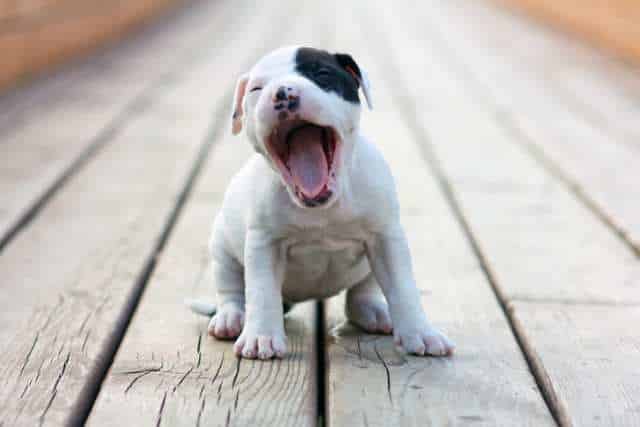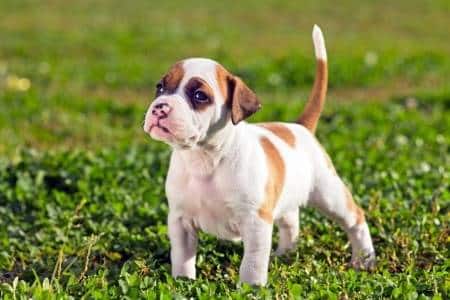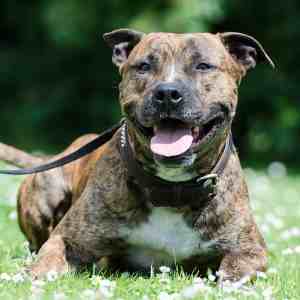Aggressive Pit Bull or Loving Family Dog?
To some, the American Staffordshire Terrier means only one thing – PIT BULL – and with that comes all the negative propaganda that has spread throughout the news at every level, prompting breed bans and high insurance rates.
To many, all they see is a vicious fighting dog that should be banned if not destroyed. Just how much of this rhetoric is accurate of this breed?
It is true that the American Staffordshire Terrier has suffered and gained a bad reputation. However, while they are strong, powerful, and courageous, they are not vicious.

Rather, the well-bred, trained American Staffie Terrier is a docile, affectionate family guy who will be protective his family.
American Staffordshire Terrier
Temperament
As a whole, these dogs are smart, entirely devoted to their family, gentle and loving. They are playful even into old age and active.
They thrive when they are with their family, friendly and docile and enjoy any kind of activity that challenges them both physically and mentally.
Dog on Dog Aggression / Other Pets
Some dogs can be aggressive towards other dogs, especially those of the opposite sex. Historically many of them were bred to fight other dogs, and this trait may take generations to breed out. Neutering males usually make them less like to fight.
They may also be unpredictable around other small pets such as cats or rabbits. They have an extremely healthy prey drive and without proper socialization and training, they should not be trusted.
The best way to assure your American Staffordshire Terrier is good with other pets is to raise them with others from the time they are puppies.
Of course, there are exceptions to every rule. Some live for years around a household full of other animals without an incident.
There is always the chance, though, with any bully breed that something happens that creates a dangerous situation for the other dogs and pets in the household.
Have a look at the YouTube video sent to us by Mark Barkan, below.
American Staffordshire Terrier and Children
These dogs do well with kids. They are protective but playful, and very tolerant of young children. They are, however, very exuberant and love to jump.
They can be high jumpers, and when you add in all that weight, you have a potential for some accidents to happen especially with young children. Supervision is strongly advised.
They generally do very well with people. With that said, the “pit bull type dogs” have a notorious reputation for being dangerous and implicated in scores of lethal attacks against individuals. Most of these dogs come from aggressive lines that are more likely to strike out.
Badly bred with little or no training can create a very dangerous situation for those who may live nearby.
The dogs that have conscientious owners willing to take the time to socialize and train, enforce the rules and act like a benevolent leader will have well-behaved dogs that are not likely to be involved in any aggressive situation.
There are always exceptions, so anyone interested in these dogs should plan on spending extra time training them. Don’t settle on a puppy that has a questionable temperament.
I am not trying to downplay the seriousness of dog attacks on humans, but the real problem with this breed is their strength. A vicious attack by a Chihuahua will leave a nasty bite and possible scar. An attack by an AmStaff could be fatal.
Add power, an unstable personality due to poor breeding, and inadequate training and you have a dog that could inflict substantial damage on another person.
Intelligent, Active, People-oriented

These dogs are highly intelligent and need something to keep their mind and body active. If left alone for too long, they can become destructive. They need plenty of fresh air and vigorous exercise, but they are generally calm and quiet indoors, at least after they pass the puppy stage.
They are happiest when they have a job to do. Daily training activities accomplish this, as does allow them to participate in a canine sport. They excel in many different types of canine sports including weight pulling, agility, flyball, lure coursing and obedience.
Their highly athletic abilities and stamina would make them an excellent choice for someone who jogs, runs or enjoys cycling. They need daily exercise in the form of long walks or romps in a securely fenced yard. If provided with enough exercise, they can live in an apartment.
If this breed is on your radar, be sure you know what you will be getting into. This is not a breed for an inexperienced dog owner or one who lacks confidence and the willingness to provide the necessary activities that will keep these dogs happy and satisfied.
History of the American Staffordshire Terrier
Like many of the breeds that people mistakenly call pit bulls, the American Staffordshire Terrier can trace their beginnings to 19th century England. For as sweet as these dogs are today, it is hard to imagine a breed with a bloodier beginning.
Two prominent breeds go into the mix to create these dogs, but it is not certain exactly which breeds were used. We know for sure that the early Bulldogs of the day were carefully bred for the purpose of bull baiting. Bull baiting was the act and sport of dogs grabbing the noses of the cattle while the butcher killed them before slaughter.
These early Bulldogs do not resemble what we consider the English or British Bulldog to look like by today’s standards.
Early Bulldogs were agile, muscular and stood straight on longer legs and even possessed a distinct muscle. The closest modern comparison I can see to these old Bulldogs is the American Bulldog.
Breeders then crossed this old time bulldog with a terrier breed or two to create a bull and terrier breed.
Some experts suggest that the terrier breeds that were used were the old white English Terrier or the Black and Tan Terrier (now called the Manchester Terrier).
As of this writing, I have not found any consensus among writers as to the terrier used. Some suggest it was the fox terrier. The purpose was to create a dog that would combine strength and tenacity with agility and high-spirit.
There were no breed standards at the time, so breeders work to create dogs that would perform a particular task and paid little attention to the dog’s appearance.

By this period, bull baiting had morphed into catching rats in a pit. This sport required the dogs to catch as many rats running around in pits and naturally there was plenty of gambling and bets on whose dog would win.
Eventually, several breeds arose, the Bull Terriers and the Staffordshire Terriers, which were formerly called Bull and Terrier Dogs, Half and Half dogs, or Pit Dogs, and which eventually became known in England as the Staffordshire Bull Terrier.
From killing rats, these dogs eventually found themselves in the ring fighting other animals including bears and other dogs.
By 1880, these dogs were being brought to the United States from England and Ireland, where they were called Pit Dogs, Pit Bull Terriers, American Bull Terriers or Yankee Terriers.
Today’s American Staffordshire Terriers can trace their roots back to a group of dogs imported by John P. Colby.
In the late 1800s, the two American breeds that were initially identical were separated. In 1898, the United Kennel Club was formed so that they could register and provide guidelines for all the pit type dogs that had been used in dog fighting. The American Pit Bull Terrier became their very first breed.
But those breeders who wanted to separate themselves from the fighting background of the breed asked the AKC (American Kennel Club) to recognize the American Pit Bull Terrier breed so they could also participate in shows, performance and conformation.
The AKC finally accepted them in 1936 with the stipulation that the breed was named “Staffordshire Terriers,” from the county in England in which the breed supposedly originated.
The name ‘Staffordshire Terrier’ was very similar to the British Staffordshire Bull Terrier, so in 1972 the name was changed to the ‘American Staffordshire Terrier’ to distinguish the two breeds.
It should be noted that not every bull and terrier type dog found themselves in a fighting arena. Most of them were used as all-purpose farm dogs, helping farmers with livestock and guarding the farm. Today, the American Staffordshire Terrier ranks at #80 in popularity among AKC breeds.
Vital Statistics
Height:
Males 17 – 19 inches (43 – 48 cm)
Females 16 – 18 inches (41 – 46 cm)
Weight:
Females and Males: 62-88 lb (28-40 kg)
Life Expectancy: 9-15 years
Registration: American Staffordshire Terrier: AKC, FCI, ANKC, CKC, NZKC
Other Names Used for the American Staffordshire Terrier: Am Staff, Staffie, Staffy, American Staffy
Country of Origin: United States
Colors
According to the AKC standard this breed can come in 18 colors:
- Black
- Black Brindle
- Blue
- Blue Brindle
- Blue Fawn
- Blue Fawn Brindle
- Bronze
- Bronze Brindle
- Fawn
- Fawn Brindle
- Fawn Sable
- Liver
- Liver Brindle
- Red
- Red Brindle
- Red Sable
- Seal Brown
- White
Markings: Black Mask, Blue Mask, Brindle Points, Spotted, Patched, Patched or Spotted, Tan Points, White Mask, White Markings.
American Staffordshire Terrier – Ease of Training

Training is necessary for these breeds, and ongoing practice is a must. They are a sensitive group of dogs that like to please and unlike some of the other bully breeds, respond very positively to praise instead of food – but don’t rule out food treats entirely!
These dogs like to be in charge, so it is important to let them know that you are the boss. Any games that might be construed as vying for dominance should be avoided, such as tug of war.
These powerfully-jawed dogs may try to fight to get their own way, and we may send the wrong message to them by competing, according to some dog trainers.
Bull dog experts suggest that play should be separate from training sessions for the best results. Some owners report problems with housebreaking. Crate training works well with this breed, but the real trick is to start the day the puppy comes home, with a strict schedule and praise when the puppy does what is expected.
Running, chasing, jumping, digging and escaping a fenced enclosure are problems that many American Staffordshire Terrier owners report.
A dog that escapes can present a huge problem. With these breeds, it can be very dangerous. Not only are you worried about your dog’s safety around cars, but how they will respond to people who are fearful or dislike pit bull breeds.
The best way to avoid this situation is to be with your dog when he is outside. They are less likely to try and escape if their owners are nearby.
The other thing that owners do is to practice the “come” command so that you can safely say your dog responds to all recall commands.
Fencing is vital and should be high enough to prevent the dog from jumping over the fence. Invisible fencing may work for some breeds but is not recommended for the American Staffordshire Terrier.
Protection
Staffies can provide protection for you and your family either as a watchdog or as a guard dog. Depending on the line from which your dog arose, they can be reserved with strangers to highly friendly.
Their size and strength alone can be a deterrent to some would-be intruders. For the most part, though, they are non-aggressive.
American Staffordshire Terrier – Grooming

The American Staffordshire Terrier is very easy to groom. Brushing once or twice a week will help remove dead hairs and cut down on the amount of shedding.
An occasional bath or dry shampoo, when needed, will keep them looking their best. Some members of the breed drool, so keep a little towel handy to wipe away the slobber.
Other than that, there are just the basic tasks common to all dogs. Clip nails about every 2 to 3 weeks and attend to their dental hygiene by brushing their teeth as often as possible.
Check their ears and clean if you notice a buildup of wax or debris. If they appear red, inflamed or if the dog is scratching or shaking his head, make an appointment to see the vet.
Health Considerations

These dogs are generally healthy and live a relatively long life for a large dog breed. As with all dog breeds, some genetic problems have been identified.
The major problems that have been listed for this breed are:
Hip Dysplasia
This is a very common orthopedic problem in dogs where the hip joint and/or the socket is malformed. Dogs used for breeding can be x-rayed and evaluated before mating. They should be able to pass either the OFA or the Penn Hip evaluations.
Elbow Dysplasia
This is similar to hip dysplasia except the malformation occurs at the elbow joint rather than in the hips.
Luxating Patella
This conditions when there is a reoccurring dislocation or slipping in and out of the kneecap that can cause pain and lameness.
It is noticeable when the dog walks, first normally and then immediately carrying the hind leg up and off the ground.
Hypothyroidism
This is an endocrine disorder where the thyroid glands produce an abnormally small amount of hormones. It is usually caused by an autoimmune destruction of the thyroid gland and causes symptoms of fatigue, hair loss, weight gain, chronic skin infections, intolerance to cold and infertility.
Heart conditions
Several cardiac diseases have been reported in the American Staffordshire Terrier including mitral and tricuspid valve murmurs, subaortic stenosis, pulmonary valvular stenosis, and cardiomyopathy.
Dogs used for breeding should be examined by a cardiac veterinarian, and anything usual can be confirmed by Doppler or cardiac ultrasound.
Skin allergies that lead to infections
Skin allergies can occur in all dogs and with intense scratching, rubbing and licking, the areas of the skin can become inflamed and lead to infections. There seems to be some evidence that American Staffies are more prone to infections than other breeds.
Demodectic Mange
This is an inherited skin condition brought on by stress on the immune system. Adolescents are most prone, and it starts as a few small patches of hair loss and inflammation on the head or body.
Eye Diseases
There are several eye diseases known to occur in the AST. Progressive Retinal Atrophy, juvenile cataracts and entropion have all been identified. Annual tests for breeding dogs should be done by a certified veterinary ophthalmologist.
Progressive Retinal Atrophy (PRA)
This inherited eye disease causes the slow deterioration of the retina producing night blindness and eventually total blindness
Juvenile Cataracts
Cataracts cause clouding over of the lens of the eye resulting in blindness. Juvenile cataracts occur in young puppies and are caused by inherited by receiving autosomal recessive genes from both parents.
Entropion
An inherited condition which causes one or both of the eyelids to turn inwards toward the eye, causing the eyelashes to irritate the eye itself.
Inherited Deafness
Cerebellar Ataxia:
A disease in which the dog suffers the death of brain cells in the cerebellum resulting in multiple neurological symptoms. Often dogs are euthanized. There is a DNA test for this disorder offered through Optigen Laboratories. All dogs used for breeding should be tested.



